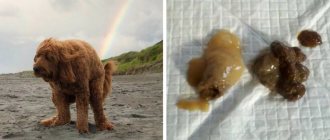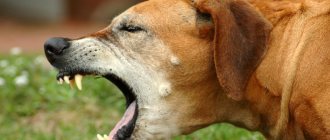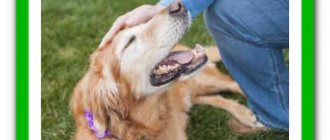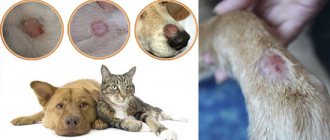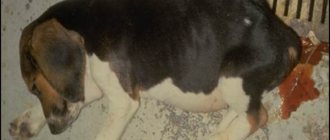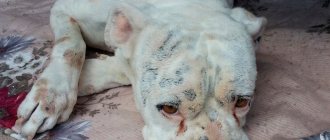The appearance of foam from a dog's mouth is one of the key symptoms of rabies. This disease is fatal not only to animals, but also to humans. Despite the possible danger, foaming is caused not only by pathologies, but also by completely harmless reasons. The accompanying symptoms that determine first aid actions will help you understand the possible diagnosis.
What does foamy discharge from the mouth look like?
The appearance of foamy liquid occurs during a chemical reaction of oxygen with saliva and gastric mucus. It is similar to soap formations, but may contain veins and inclusions. Color and consistency often help determine the root cause of the appearance.
The foam itself is not dangerous, but sometimes it acts as a symptom of diseases of the digestive system and other pathologies. The presence of violations is indicated by an increase in the amount of fluid coming out, more frequent attacks of vomiting, and the appearance of accompanying symptoms.
Reasons for violation
The causes of a possible violation are physiological and pathological. The former occur in healthy animals for natural and non-hazardous reasons. The latter are associated with serious disorders of an infectious and non-infectious nature that threaten the health of the animal.
Physiological
Most physiological reasons are associated with the peculiarities of the digestive process. These include:
- Prolonged fasting. A long absence of food leads to increased production of gastric juice, which irritates the mucous membranes. As a result, white foam flows from the dog’s mouth.
- Quick swallowing of food. Occurs in the absence of satiety or prolonged fasting.
- An accumulation of hairballs or grass. Hair and plants are difficult to digest and are often removed by the body through vomiting. In this case, the foamy mucus has a green or yellowish tint and contains particles of fur.
- Eating bitter or salty foods. They irritate the receptors, stimulating saliva production. This often happens when a dog is given a bitter medicine.
Also, excessive salivation occurs when chips get stuck between the teeth or a foreign object gets into the digestive tract. In both cases, saliva comes into contact with oxygen and begins to bubble. Danger arises when blood appears. This occurs when soft tissue is damaged, so the animal should be shown to a veterinarian.
Foamy saliva also appears when taking pills. Dogs do not like to swallow them the first time, so wandering around the mouth leads to temporary drooling.
If your dog is foaming at the mouth, make sure there are no stress factors. The reaction can also be caused by motion sickness during a long trip or toxicosis. Such cases are rare. Symptoms resolve on their own.
Large, loose folds located around the jaws of Bulldogs and Boxers prevent saliva from being retained in the mouth. The slight foamy discharge in these breeds is explained by their anatomical structure.
Pathological
If the appearance of foamy liquid is accompanied by other symptoms and a sharp deterioration in the condition, contact your veterinarian immediately. In this case, there is a high probability of a pathological cause:
- Viral infections (rabies, enteritis, distemper, Aujeszky's disease). Self-medication for these diseases is useless, and in the case of rabies, it is dangerous for humans. If your pet avoids light, and its behavior has suddenly changed to the opposite, isolate it and call a veterinarian.
- Neoplasms in the esophagus and oral cavity. A biopsy is used to confirm or refute oncology.
- Diseases of the cardiovascular system. In case of cardiac pathologies, blue mucous membranes and the appearance of a dry cough are noted.
- Food poisoning. Eating spoiled or poisoned substances causes intoxication. Along with vomiting, the body tries to get rid of the toxins it has received.
- Dental diseases. Due to the presence of pathogenic microorganisms that change the chemical composition, the dog's saliva looks like foam.
- Epilepsy. The disease is incurable, so the owner can only stop subsequent attacks. Those at risk include spaniels, poodles and labradors.
- Helminthiases. Foamy vomit occurs when infected with esophageal worms.
- Diseases of the pancreas and gall bladder. The appearance of yellow foam in a dog that has not eaten grass is due to bile that has entered the stomach. This problem is typical for small breeds.
- Stomach bleeding. Foamy liquid, colored brown, indicates injury to internal tissues.
- Brain damage. Concussions, inflammation, swelling and bruises are accompanied by vomiting, heavy breathing and loss of consciousness.
To eliminate these pathologies, a thorough diagnosis is necessary. Attempts at self-treatment can aggravate the patient’s condition or lead to his death.
After anesthesia and surgery
A separate reason is operations performed under general anesthesia. Anesthesia is toxic, so it will take some time to remove it from the body. After sterilization or other surgical intervention, the animal’s temperature decreases and the mucous membranes turn pale. On the first day, mild cramps, diarrhea and nausea are acceptable. If the condition does not stabilize, see a veterinarian and surgeon.
Associated symptoms
Record each of the accompanying symptoms in detail. They will help the veterinarian during diagnosis.
Shaking your head
If your pet shakes its head, check its mouth. He may be trying to get rid of stuck wood chips or other foreign objects.
Convulsions
If your dog is foaming at the mouth and has convulsions, the cause may lie in an epileptic seizure or poison intoxication. Convulsions in epilepsy are accompanied by involuntary urination and bowel movements, as well as complete disorientation in space. In case of poisoning, dilation of the pupils and a decrease in body temperature are noted.
Vomiting and gastrointestinal upset
If your dog comes out of his mouth not only with foam, but also with vomit, examine the color and consistency of the vomit. This will be needed when collecting anamnesis.
When an animal vomits, it is often tormented by painful spasms and diarrhea. Such symptoms are extremely dangerous for puppies, as they quickly dehydrate the body.
Heart rhythm disturbances
Count your heart rate or the number of breaths you take in minutes. Rapid breathing may cause cardiac arrest, so contact your veterinarian for further advice.
Survey
Diagnosis of a neurological disease includes a set of instrumental examinations aimed at identifying its cause. Since this symptom can be caused by a number of ailments of a very different nature, the diagnosis should be as comprehensive as possible. When making a diagnosis, the patient’s age and lifestyle are always taken into account.
The owner needs to find out whether any of the dog’s ancestors had similar symptoms. It is also very important to remember whether the dog had significant injuries or head hits.
The following types of surveys are the most informative:
- magnetic resonance and computed tomography of the brain and spinal cord;
- ultrasound examination of the abdominal cavity;
- radiography of the bones of the skull and spine;
- electrocardiogram of heart contractions;
- detailed blood test.
It must be borne in mind that seizures in an elderly person may often indicate liver disease, kidney disease, or heart problems. Puppies and young dogs are more often susceptible to epilepsy, and calcium deficiency (eclampsia) is experienced by pregnant and lactating females, as well as small breed dogs.
Help and treatment
Foaming from the mouth in a puppy or adult dog for no apparent reason is an alarming symptom that requires diagnosis. To eliminate it, you will need to deal with the root cause.
The owner's first actions
If you do not have the opportunity to immediately go to a veterinary clinic, provide first aid to your pet. To alleviate his condition you will need:
- Provide access to clean water. If the animal refuses to be fed, do not insist. For severe vomiting, use ice cubes instead of plain water.
- Give a deworming tablet. If found in stool or vomit, collect a sample for laboratory diagnosis.
- Lay the body on the right side in case of an epileptic attack. Hold your dog's head to prevent him from choking on foam and swallowing his tongue. Remove all dangerous objects from the pet's vicinity and wait until the seizure ends.
- Give activated carbon. In case of poisoning, the sorbent is given every 4 hours.
- Examine the oral cavity. If you find a splinter, “rain” or threads, carefully remove them out. Leave sharper objects for the vet.
In most cases, self-medication is ineffective, so try to take the animal to a veterinarian. Further treatment will be prescribed after diagnosis and identification of the cause.
Medicines prescribed by your veterinarian
Viral and bacterial infections are treated with antiviral drugs or antibiotics, respectively - they prevent the addition of secondary diseases. Immediately after infection, immune serum can be used. If a dog is diagnosed with rabies, it will have to be euthanized, since this disease cannot be treated.
Surgery is used to eliminate tumors. If cancer is detected, chemotherapy may be used.
Heart pathologies require gentle nutrition and the use of medications that support the functioning of the organ. Swelling is relieved with diuretics.
Toxins trapped during poisoning are removed by washing. An antidote is used to eliminate the harmful effects of poisons.
Dental pathologies are eliminated under anesthesia. The animal's teeth are cleaned, caries, stomatitis and other diseases are removed. If gum damage is severe, antibiotics are prescribed.
New attacks of epilepsy are suppressed by taking anticonvulsants, and helminths are fought with anthelmintics. The greatest effect is provided by broad-spectrum drugs that act on several groups of parasites at once. Large gallstones are removed surgically under general anesthesia.
In case of internal bleeding and brain damage, the animal is placed in a hospital. Once the dog's condition has returned to normal and the dog's mouth has stopped foaming, the veterinarian will decide what to do next, depending on the severity of the situation.
Prevention of “foamy syndrome”
Dog lovers try to prevent abnormal drooling in their dogs:
- When walking with a barking companion, do not allow him to grab anything from the ground.
- They train the puppy’s vestibular apparatus, accustoming it to travel and gradually lengthening transport routes. “Just in case,” they keep anti-motion sickness products in the glove compartment or pocket.
- They monitor the balance of the patient’s diet and gradually and in small doses offer him new foods.
- They do not miss deworming deadlines and adhere to the vaccination plan.
- The fight against cutaneous bloodsuckers is carried out without deviating from the instructions; antiparasitic drugs are applied to areas inaccessible to the animal.
- Toxic substances are carefully hidden from the ubiquitous tailed bloodhounds.
With a caring and sensitive owner, a pet is not afraid of many dangers. If something bad happens, don’t panic. You need to act according to the situation and go to the clinic if you have the slightest doubt about your own abilities.
